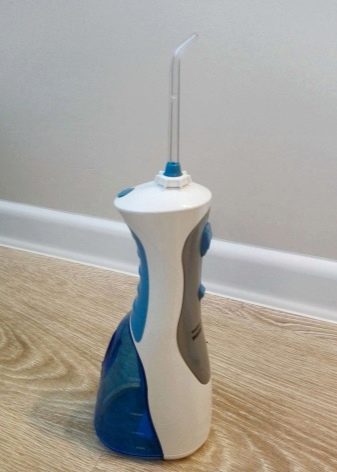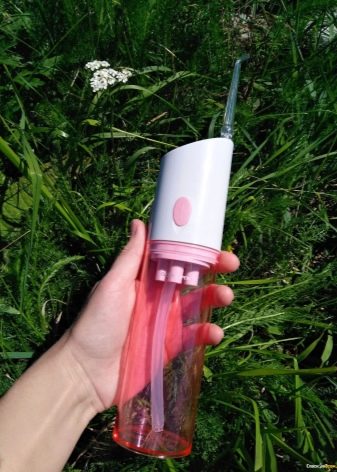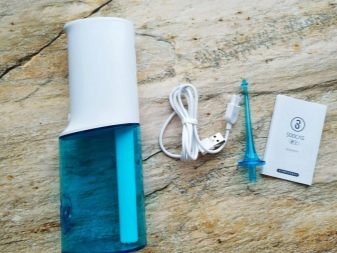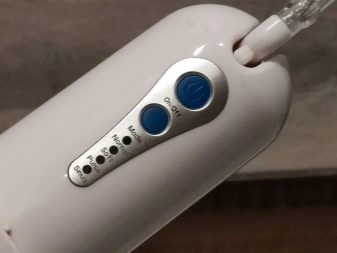All About Portable Irrigators

With daily oral care, the number of visits to the dentist is reduced. With a quality irrigator, oral hygiene is more effective. Its use prevents tooth decay, gum disease, and plaque formation. It is especially convenient to use a portable device. It is recommended for children and on trips, despite the fact that it is enough to just take care of it.

What it is?
The portable irrigator serves as a faithful assistant in maintaining the health of the oral cavity. The device will help save on cleaning at the dentist, as it allows you to independently remove plaque.
Irrigator is optimal for the implementation of oral hygiene in hard-to-reach areas.
It perfectly cleans the interdental spaces and gums with a stream of water or solution and has no categorical contraindications for use.

Portable device of compact size operates on battery power without being tied to the mains. But even such an irrigator is able to effectively care for the oral cavity, which is of great importance for dental health.

Advantages and disadvantages
The device is no worse than the stationary version, it perfectly complements the care of braces, implants and prostheses. Suitable for the whole family, of course, when using interchangeable attachments. However, the portable irrigator has many more advantages.
- A portable device is convenient to carry with you, providing the usual dental care outside the home.
- Large selection of models. You can purchase a device of the best value without harming your budget.
- Saving money on cleaning your teeth in dentistry.
- Waterproof case.
- Lightweight and comfortable to use. The small weight of the device does not bother during its use.
- It does not need power from the mains, it works in an autonomous mode for a long time.
- The portable irrigator works without unnecessary noise and vibration.
- The device painlessly and quickly copes with plaque accumulated in the mouth and destroys pathogenic microflora.
- Various attachments are supplied in the kit.

The disadvantages include:
- a small volume of the tank (200 ml), for a thorough cleaning you will need to top up the liquid;
- nozzles do not rotate around their own axis;
- there is no automatic end of the work cycle.


Views
Irrigators can be of different types:
- battery-poweredthat can be charged in a special device, the waterproof rechargeable copy is convenient on the road;
- pocket wireless device can work from batteries, it is enough to have a supply of them with you;
- the compact irrigator can be charged from the network, this charge usually lasts for several days.



Also, such devices differ in the type of water supply.
- Monojet... With connection to a water tap. They are similar in design to a handle with a nozzle on one side and a thin tube on the other, with a tap adapter at the end. Inexpensive battery-type devices, but not without drawbacks. These include the low efficiency of cleaning, the need to constantly rearrange the adapter. Using tap water may not be safe in every region.
- Impulse... The liquid from the device is supplied in pulses. High frequency water hammer (800–3000 im / min) is effective in removing dental plaque. The impulse irrigator is indicated for persons at risk for dental diseases (children, with a lack of vitamins and minerals, regular eating of solid, sweet foods, with bad habits, etc.). Such efficient devices are very expensive.
- Microbubble... The most efficient and costly modern irrigators. The jet is supplied impulsively, enriched with air thanks to special nozzles. The resulting microbubbles burst when in contact with the enamel and contribute to a more effective removal of pathogenic microflora.



Model rating
Among such devices as irrigators, there is a top of the most demanded and purchased.
- CS Medica AquaPulsar CS-3 Air Plus. Rechargeable device for easy cleaning of the oral cavity from plaque. A budget home option and a must-have when traveling. The small 130 ml tank does the job perfectly. Four interchangeable attachments can be conveniently folded into a dedicated storage compartment. The device is guaranteed for three years. The price for such an acquisition is equal to the cost of one cleaning in the dental office. A profitable purchase for a large family.
The device is lightweight even for use by children. A good addition to the care of braces.


- WaterPik WP-450 Cordless Plus. Impulse cleaner suitable for teeth, gums, crowns, etc. The impulse jet very effectively cleans teeth from accumulated plaque and prevents tooth decay. 210 ml reservoir, convenient adjustment of the pressure at the outlet of the jet. The lightweight model is pleasant to hold in hand due to its low weight and material from which the case is made. There are additional attachments in the amount of four and two operating modes. A good device for small users, for those with sensitive gums, crowns or implants. The charge is enough for 6-7 days.


- VES VIP-008. The budget option will replace dental floss and toothpicks. The small tank of the purifier does the job well. Additional attachments are stored in a special compartment. The jet is delivered comfortably, suitable for use by young children and people with sensitive gums. The small size allows you to store the stylish device in the closet. At an inexpensive cost, the device has great potential.It works in three modes, which allows each household to choose the appropriate strategy individually.
There is a special base for recharging the device and a timer to control the cleaning time.


- Philips AirFloss Ultra HX8432 / 03. New mobile multifunctional model of the middle price category. The irrigator is capable of operating without refueling for 2 weeks. Effectively removes plaque from teeth and loosens the gaps between them. Easy to use. Equipped with a section with additional attachments. An acceptable option for a small family. Other attachments can be purchased as needed. The stylish design of a well-built cleaner has one drawback: high cost. But his work will surely pay off every ruble invested.


- B. Well WI-911. A budget appliance that does a good job of regular cleaning. Low-power jets produce a cumulative effect - they do not immediately remove the plaque layer with a single application, but they perfectly solve this problem in several procedures. In continuous operation, the irrigator has enough charge for 60 minutes. A small reservoir is sufficient for delicate trickle cleaning. For thorough oral hygiene, you will need to refill the container twice.
The device is suitable for treating gums with hypersensitivity and for children.


- Rokimed RKM-1701 / RKM-1702... The budget model is suitable for those who are looking for a reliable assistant in the implementation of oral hygiene on the road and at home. The surprisingly low cost allows you to try out the device and determine if you need to order something more expensive in the future. The irrigator is equipped with an auto-off function. Charging is done via a USB cable. The charge is enough to carry out a high-quality cleansing procedure. The set includes several attachments. A 150 ml reservoir of liquid helps eliminate plaque and reduce tartar formation. Perfectly washes out braces too. The budget device is good for travel.
Of the minuses, it can be noted that the modest volume of the tank is not capable of providing a powerful jet output.


How to choose?
Before purchasing a device, you have to decide on the number of people for whom it is calculated, calculate the required number of nozzles and the volume of the tank, which allows you not to interrupt the hygienic procedure to add a portion of liquid. If it is a travel device, you need to consider how long the travels are.


When choosing a non-stationary irrigator operating from a built-in battery, the following parameters must be taken into account:
- operating mode (pulsation, micromassage, floss, turbo flow, etc.);
- equipment;
- pulsation frequency (900 - 3000 pulses / min.) Optimally - 1200 pulses / min;
- battery type and capacity;
- capacity (120-250 ml.);
- water supply technology.


It should be remembered that some little-known manufacturers supply devices that often cannot be repaired due to the lack of spare parts on sale.
Therefore, it is better to opt for a well-known brand that gives guarantees for its products.

Power
A portable oral device should have a power rating in the range of 250 - 600 kPa.


Jets
The solution is fed through the device in one continuous or several short streams, and also in the form of a liquid enriched with oxygen. It is necessary to adjust the pressure level depending on the purpose and condition of the gums and teeth. If the device is intended for use by children, you can select the model with a weak jet. Adults need more intensive cleansing, except for those with sensitive gums. You can use an irrigator with special medical fluids added to the reservoir. The irrigator helps to strengthen the gum tissue, but it is important to increase the pressure force gradually, up to the maximum (700 KPa), with which the desired therapeutic effect can be obtained.

Nozzles
The standard set includes up to 4 attachments. You can purchase the device with one or a dozen replaceable attachments.The more attachments there are, the better the cleaning of the oral cavity will be. In addition, the device with interchangeable attachments can be used by several people at once, which is convenient in a large family.


The most common attachments can be distinguished.
- Standard... For complex oral hygiene: it washes the mucous membrane, massages the gums, cleans the interdental space and gum pockets.
- For gum pockets... With silicone or rubber tip for effective cleaning of the gum rim.
- For braces, bridges, implants and crowns. Equipped with fine bristles or a very fine nozzle for the best water penetration into the spaces of complex dental structures.
- For the language. Rounded tip for removing plaque from the tongue and eliminating unpleasant odors.
- Brush attachment... A conventional irrigator is not capable of being a full-fledged replacement for a toothbrush. It only completes the oral hygiene and improves it in hard-to-reach areas. With this attachment, the toothbrush loses its relevance.
- For the nose. To prevent / eliminate rhinitis. Rubber tip. Relevant for babies and people with allergic rhinitis.

There can be a large number of attachments. You need to choose according to your own needs.

Nutrition
The built-in battery is charged via a USB cable. The set contains a rechargeable battery or batteries. Their charge is sufficient to provide power to the irrigator for several sessions of use.


Pressure regulation
It is better to choose devices that have a function for adjusting the jet pressure. Usually this is a special button on the body.


How to use?
It is necessary to fill in the reservoir of the irrigator only boiled or filtered liquid at a comfortable room temperature. You can use special rinses that are diluted with water according to the instructions. They are prescribed by a dentist as a treatment course. They are not used on an ongoing basis. Also, it is forbidden to use antiseptics, any chemicals and medicines as filling in the tank. To clean your mouth with an irrigator, do not use mouthwash or toothpaste solution. All this can damage the device.
The battery must be fully charged before cleaning the oral cavity. The charge will last for several sessions. After the device is prepared, you need to brush your teeth with a toothbrush or such a nozzle on the irrigator. Next, a cleaner is connected to the case. The device must be held at an angle of 90 degrees in relation to the treated area, directing the jets from top to bottom, taking into account the location of the gums. Instructions for the irrigator are required reading!


Review overview
According to many dentists, an irrigator is an indispensable device for thoroughly cleaning the oral cavity. The device perfectly helps in the prevention of dental diseases. According to professionals, microbubble and pulse cleaning technologies are the most effective. They remove dirt in areas where toothbrushing is in vain. This means that cleaners can help prevent a number of dental diseases. With irrigators, it is possible to normalize the microflora in the mouth, strengthen the blood vessels. Professionals recommend changing the tips every few years. It is better to choose devices with a jet pressure adjustment button.
Users are generally satisfied with the battery life of the device. It does not need to be recharged frequently. One full charge is enough for two people to use for two weeks. The device helps to maintain clean enamel by preventing the formation of hard deposits by eliminating impurities in gingival pockets.

Should you buy an irrigator? Of course, if you need to take good care of oral hygiene. The toothbrush only removes 85% of plaque. The rest of the contamination remains in hard-to-reach places, on the mucous membrane. The device helps to remove all plaque, preventing the development of dental diseases... The irrigator is also recommended for people with orthodontic constructions: bridges, veneers, implants, braces, crowns.
Many potential buyers are stopped by the cost of high-quality and durable devices. Most people take a long time to find the optimal quality model at an affordable price.









